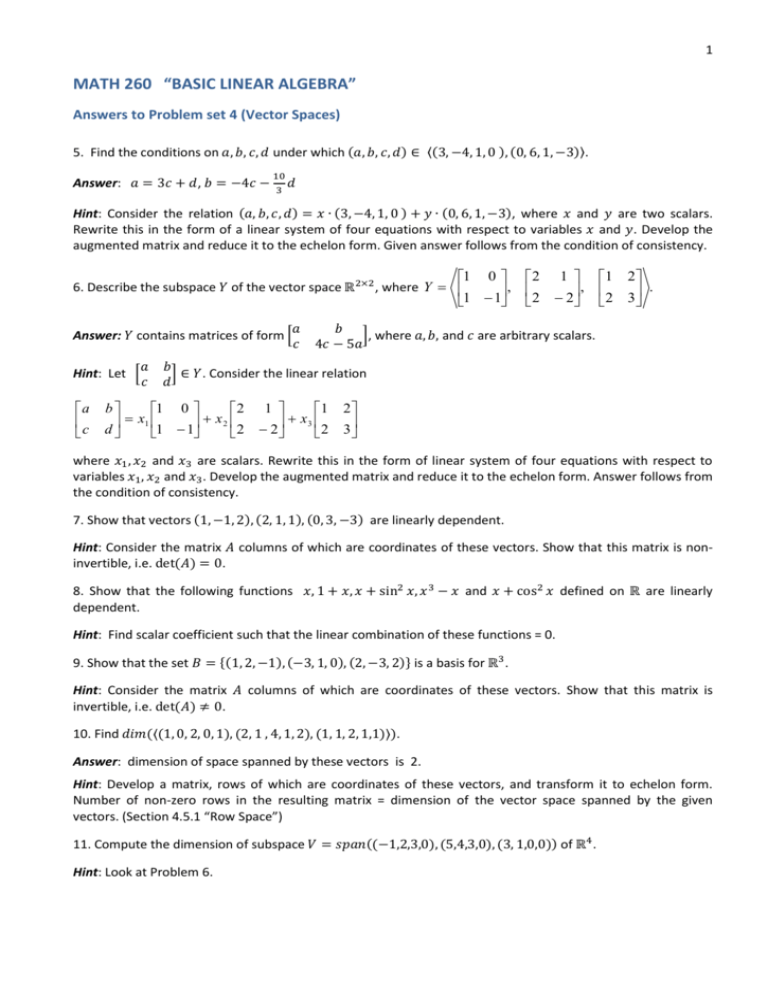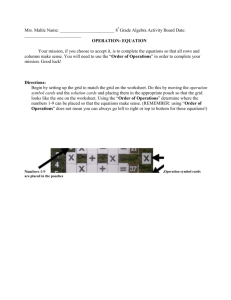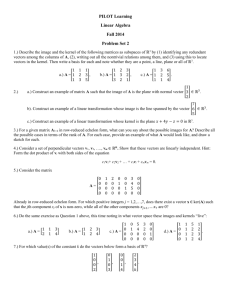MATH 260 “BASIC LINEAR ALGEBRA”
advertisement

1
MATH 260 “BASIC LINEAR ALGEBRA”
Answers to Problem set 4 (Vector Spaces)
5. Find the conditions on 𝑎, 𝑏, 𝑐, 𝑑 under which (𝑎, 𝑏, 𝑐, 𝑑) ∈ ⟨(3, −4, 1, 0 ), (0, 6, 1, −3)⟩.
Answer: 𝑎 = 3𝑐 + 𝑑, 𝑏 = −4𝑐 −
10
𝑑
3
Hint: Consider the relation (𝑎, 𝑏, 𝑐, 𝑑) = 𝑥 ∙ (3, −4, 1, 0 ) + 𝑦 ∙ (0, 6, 1, −3), where 𝑥 and 𝑦 are two scalars.
Rewrite this in the form of a linear system of four equations with respect to variables 𝑥 and 𝑦. Develop the
augmented matrix and reduce it to the echelon form. Given answer follows from the condition of consistency.
1 0 2 1 1 2
,
,
.
1 1 2 2 2 3
6. Describe the subspace 𝑌 of the vector space ℝ2×2 , where Y
𝑎
Answer: 𝑌 contains matrices of form [
𝑐
Hint: Let [
a
c
𝑎
𝑐
𝑏
], where 𝑎, 𝑏, and 𝑐 are arbitrary scalars.
4𝑐 − 5𝑎
𝑏
] ∈ 𝑌. Consider the linear relation
𝑑
b
1 0
2
x1
x2
d
1 1
2
1
1
x3
2
2
2
3
where 𝑥1 , 𝑥2 and 𝑥3 are scalars. Rewrite this in the form of linear system of four equations with respect to
variables 𝑥1 , 𝑥2 and 𝑥3 . Develop the augmented matrix and reduce it to the echelon form. Answer follows from
the condition of consistency.
7. Show that vectors (1, −1, 2), (2, 1, 1), (0, 3, −3) are linearly dependent.
Hint: Consider the matrix 𝐴 columns of which are coordinates of these vectors. Show that this matrix is noninvertible, i.e. det(𝐴) = 0.
8. Show that the following functions 𝑥, 1 + 𝑥, 𝑥 + sin2 𝑥, 𝑥 3 − 𝑥 and 𝑥 + cos 2 𝑥 defined on ℝ are linearly
dependent.
Hint: Find scalar coefficient such that the linear combination of these functions = 0.
9. Show that the set 𝐵 = {(1, 2, −1), (−3, 1, 0), (2, −3, 2)} is a basis for ℝ3 .
Hint: Consider the matrix 𝐴 columns of which are coordinates of these vectors. Show that this matrix is
invertible, i.e. det(𝐴) ≠ 0.
10. Find 𝑑𝑖𝑚(⟨(1, 0, 2, 0, 1), (2, 1 , 4, 1, 2), (1, 1, 2, 1,1)⟩).
Answer: dimension of space spanned by these vectors is 2.
Hint: Develop a matrix, rows of which are coordinates of these vectors, and transform it to echelon form.
Number of non-zero rows in the resulting matrix = dimension of the vector space spanned by the given
vectors. (Section 4.5.1 “Row Space”)
11. Compute the dimension of subspace 𝑉 = 𝑠𝑝𝑎𝑛((−1,2,3,0), (5,4,3,0), (3, 1,0,0)) of ℝ4 .
Hint: Look at Problem 6.
2
Find a basis for ⟨1 + 𝑥 2 , 1 + 𝑥 + 𝑥 3 , 1 + 𝑥 2 + 𝑥 3 + 𝑥 4 , −1 + 𝑥 2 + 𝑥 4 , 𝑥 3 + 𝑥 4 ⟩.
Hint: Look at Example 4.5.1 2) (p. 174 of the textbook).
12. Find a basis for the space of polynomials 𝑃3 containing 𝑥 and 𝑥 + 𝑥 2 .
Hint: Look at Example 4.5.3 2) (p. 178 of textbook).
13. Extend {1 + 𝑥 2 , 𝑥 + 𝑥 3 } to a basis of the space of polynomials of degree ≤ 3.
Hint: This problem is similar to previous one, but formulated in different way. Follow Example 4.5.3 2) (p.
178 of textbook).
14. Find a basis for a subspace spanned by 4 × 1 matrices
1
2
1
3
1
2
1
3
4
0
X1
, X2
, X3
, X4
, X 5 .
1
1
0
1
0
3
0
3
3
1
Answer: 𝑋1 , 𝑋2 , and 𝑋5 .
Hint: Form a matrix (say matrix 𝐴) from the given columns matrices, and reduce it to echelon form. Columns
of matrix 𝐴 corresponding to columns of leading entries of the resulting echelon matrix form a basis. Notice
that this is a basis for column space of 𝐴. (Section 4.5.2 “Column space”)
15. Find a basis for 𝑌 = 𝑠𝑝𝑎𝑛((1, −1, 1, 0, 1), (2, 1 , −1, 1, 1), (0, 3, −3, 1, −1), (1, 0, 1, 0, 1)).
Answer: basis is {(1, −1, 1, 0, 1), (2, 1 , −1, 1, 1), (1, 0, 1, 0, 1)}.
Hint: Form a matrix as in Problem 14, reduce it to echelon form, etc.
16. Find a basis for the solution space of
−1
1
Answer: {[
],[
0
0
𝑥+𝑦+𝑧−𝑡 =0
{
2𝑥 + 2𝑦 − 𝑧 + 𝑡 = 0
0
0
]}
1
1
Hint: Find fundamental solutions. Set of fundamental solutions of the homogeneous system forms a basis for
the solution space. (Section 4.5.3 “Solution space of 𝐴𝑋 = 0”)
1 1
1
17. Let 𝐴 = [
]. (i) Find a basis for the solution space 𝐴𝑋 = 0. (ii) Find a basis for ℝ3×1 that
1 −1 −1
contains the basis constructed in part (i).
0
0
1
0
Answer: (i) {[−1]}, (ii) {[−1] , [ 0] , [ 1]}
1
1
0
0
Hint: (i) Find fundamental solutions corresponding to 𝐴𝑋 = 0. Set of fundamental solutions of the
homogeneous system forms a basis for the solution space. (Section 4.5.3 “Solution space of 𝐴𝑋 = 0”). (ii)
Consider the matrix containing column matrix that you have found in (i) and three standard basis vectors for
ℝ3×1 :
3
0 1 0 0
𝐴 = [−1 0 1 0]. Reduce this to the echelon form. Columns of matrix 𝐴 corresponding to columns of
1 0 0 1
leading entries of the resulting echelon matrix form a basis for ℝ3×1 (Notice that this is a basis for column
space of 𝐴). (Section 4.5.2 “Column space”).
18. Show that if 𝑢, 𝑣 and 𝑤 are linearly independent vectors then 𝑢 + 𝑣, 𝑢 − 𝑣 and 𝑢 + 𝑣 + 𝑤 are linearly
independent.
Hint: Consider the matrix (say matrix 𝐴) consisting of coordinate matrices of vectors 𝑢 + 𝑣, 𝑢 − 𝑣 and 𝑢 + 𝑣 +
𝑤 with respective to basis 𝐵 = {𝑢, 𝑣, 𝑤}:
1 1 1
𝐴 = [[𝑢 + 𝑣]𝐵 [𝑢 − 𝑣]𝐵 [𝑢 + 𝑣 + 𝑤]𝐵 ] = [1 −1 1]. Show that this matrix is invertible, i.e. det(𝐴) ≠ 0.
0 0 1
19. Let { 𝑢, 𝑣, 𝑤, 𝑝} be a basis for a vector space 𝑋. Find 𝑑𝑖𝑚(𝑌), where
𝑌 = 𝑠𝑝𝑎𝑛(2𝑢 + 𝑣 + 𝑤 + 𝑝, 3𝑢 + 𝑣 + 2𝑤 + 𝑝, 4𝑢 + 2𝑣 + 3𝑝, 5𝑢 + 2𝑣 + 𝑤 + 3𝑝)
Hint: 𝑑𝑖𝑚(𝑌) = to the number of linearly independent vectors in spanning set {2𝑢 + 𝑣 + 𝑤 + 𝑝, 3𝑢 + 𝑣 +
2𝑤 + 𝑝, 4𝑢 + 2𝑣 + 3𝑝, 5𝑢 + 2𝑣 + 𝑤 + 3𝑝} of the vector space 𝑌. Consider a matrix (say matrix 𝐴) consisting
of coordinate matrices of vectors 2𝑢 + 𝑣 + 𝑤 + 𝑝, 3𝑢 + 𝑣 + 2𝑤 + 𝑝, 4𝑢 + 2𝑣 + 3𝑝, 5𝑢 + 2𝑣 + 𝑤 + 3𝑝 with
respective to basis 𝐵 = { 𝑢, 𝑣, 𝑤, 𝑝}. Reduce it to the echelon form. Number of columns with leading elements
= 𝑑𝑖𝑚(𝑌). Also, notice that columns with leading elements correspond to a basis vectors for 𝑌. (Section 4.5.2
“Column space”).
20. (i) Show that 𝐵 = {(1, 1, 0), (1, − 1, 0), (0,0,1)} is a basis for ℝ3 .
(ii) Let 𝐶 = {(1, 0, 0), (0,1, 0), (0,0,1)}. Find the change of coordinates matrices (that is the transition
matrices) from 𝐶 to 𝐵 and from 𝐵 to 𝐶.
Answer: (ii) 𝑃𝐶→𝐵
1
= [1
0
1 0
−1 0],
0 1
𝑃𝐵→𝐶 =
−1
𝑃𝐶→𝐵
1/2 1/2 0
= [1/2 −1/2 0].
0
0
1
21. (i) Find coordinates of 𝑢 = 𝑥 − 𝑥 2 + 𝑥 3 with respect to the basis 𝐶 = {𝑤1 , 𝑤2 , 𝑤3 } of the vector space
𝑊 = 𝑠𝑝𝑎𝑛(𝑤1 , 𝑤2 , 𝑤3 ), where 𝑤1 = 𝑥 + 𝑥 2 , 𝑤2 = 𝑥 − 𝑥 2 , and 𝑤3 = 𝑥 + 𝑥 2 + 5𝑥 3 .
−1
(ii) Let 𝑤 ∈ 𝑊 be such that [𝑤]𝐶 = [ 2 ]. Find 𝑤.
−3
(iii) Compute the transition matrix 𝑃 = 𝑃𝐵→𝐶 from the basis 𝐵 = {𝑥, 𝑥 2 , 𝑥 3 } for 𝑊 to the basis 𝐶.
−1/5
Answer: (i) [ 1 ],
−1/5
(ii) 𝑤 = −1 ∙ 𝑤1 + 2 ∙ 𝑤2 − 3 ∙ 𝑤3 = −(𝑥 + 𝑥 2 ) + 2 ∙ (𝑥 − 𝑥 2 ) − 3 ∙ (𝑥 + 𝑥 2 + 5𝑥 3 ) = ⋯,
(iii) 𝑃𝐵→𝐶
1/2
= [1/2
0
1/2 −1/5
−1/2
0 ]
0
1/5
Hint: (iii) 𝑃𝐵→𝐶 = [[𝑥]𝐶 [𝑥 2 ]𝐶 [𝑥 3 ]𝐶 ]. Coordinate matrices for 𝑥, 𝑥 2 , 𝑥 3 with respective to a basis 𝐶 =
{𝑤1 , 𝑤2 , 𝑤3 } can be found directly by expressing 𝑥, 𝑥 2 , 𝑥 3 in terms of 𝑤1 , 𝑤2 , 𝑤3 . More “effective” solution is
reducing (by elementary row operations) the partitioned matrix
4
1 1 −1 1 0
[1 −1 1 | 0 1
0 0
5 0 0
0
0] → ⋯ → [𝐼|𝑃 ],
1
where in the resulting partitioned matrix 𝐼 is identity matrix and 𝑃 = 𝑃𝐵→𝐶 .
22. Find a basis for the row space of 𝐴 and find the dimension of the row space of 𝐴
1
1
A1
1
0
0 1 0 0
1 0 1 0
0 1 1 1 .
0 1 0 1
0 0 1 1
Hint: Reduce this to echelon form. Number of non-zero rows = dimension of the row space of 𝐴. Non-zero
rows form a basis for row space of 𝐴.
Answer: dimension = 4, basis is {(1,0,1,0,0), (0,1, −1,1,0), (0,0,2,0,1), (0,0,0,1,1)}.






